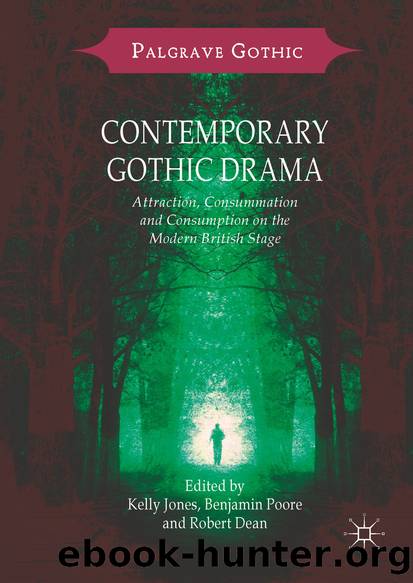Contemporary Gothic Drama by Unknown

Author:Unknown
Language: eng
Format: epub
ISBN: 9781349953592
Publisher: Palgrave Macmillan UK
This intricacy of sound continues throughout the play and needs to be as richly realised as possible in practical sound design. In the premiere production, surround-sound speakers spread around and beneath the audience created a sense of depth and genuine movement in the dark: Maxâs son seems to move around the audience as he plays and other soundscapes place us authentically in auditory environments as Max enters, terminally, a sightless world of pure sound.
While Kursk and Going Dark have developed highly sophisticated soundscapes, there are some examples of recent theatre that have pushed audio-dominated narratives on stage to the furthest degree. In productions such as Ring (2012), Fiction (2014) and Séance (2016), Glen Neath and David Rosenberg have developed sophisticated binaural sound narratives in complete darkness. Typically in their performances, a collective audience wears headphones and the light descends to blackout. The extraordinary detail provided by binauralâeffectively three-dimensional soundâcan create an exceptional mental âpictureâ wherein environments and characters âcome to lifeâ to an almost uncanny degree. Despite an aspect of âliveâ theatrical framing, most of the experiences of these performances are through pre-recorded audio taking place in theatres or studios. With Séance, the space is even more specific: it is the first part in a developing project with the overarching title Darkfield which takes place in shipping containers. The experience of collective audience and also the live framing or introductions to the productions can also create the illusion of all-live theatricality as much as the vivid authenticity of binaurality. Significantly, Neath and Rosenbergâs works can be seen as exploiting the potential of binaural darkness in explorations of the uncanny , whether this is, variously, an experiment on our perceptions, anxieties, dreams and even, in Séance, the supernatural .
Prior to the collaborations with Glen Neath, David Rosenberg developed technically ambitious projects such as Contains Violence (2008) at the Lyric Hammersmith in which the audience used binoculars and headphones to watch a performance occur in surrounding buildings. Partly in the tradition of cinematic voyeur thrillers such as Rear Window (Alfred Hitchcock 1954) or Body Double (Brian De Palma 1984), the audience observed in tension as a menacing scenario began to unfurl through a distant window. In stark contrast to the âdumb showsâ of its cinematic precursors, however, the use of headphones made the audience privy to thoughts, conversations and motivations. In a follow-up project with Fuel , Rosenberg and choreographer Frauke Requardtâs Electric Hotel (2010) once again played with the concept of the public space voyeur with audiences outside a hotel in which could be seen the disparate lives of the residents while headphones added a soundtrack which used music but also placed the audience intensely close to certain dialogue and diegetic sounds. Although not blatantly a âthrillerâ like Contains Violence, Electric Hotel presented a mosaic of tales that explored themes of isolation, grief, boredom or passion which, when mediated through our position as coolly detached voyeurs and eavesdroppers, can become an eerie experience.
For his own part, Glen Neath is a well-established radio writer with numerous BBC credits.
Download
This site does not store any files on its server. We only index and link to content provided by other sites. Please contact the content providers to delete copyright contents if any and email us, we'll remove relevant links or contents immediately.
Twisted Games: A Forbidden Royal Bodyguard Romance by Ana Huang(3665)
Den of Vipers by K.A Knight(2567)
The Push by Ashley Audrain(2562)
Win by Harlan Coben(2511)
Echo by Seven Rue(2135)
Beautiful World, Where Are You: A Novel by Sally Rooney(2033)
Leave the World Behind by Rumaan Alam(1981)
Iron Widow by Xiran Jay Zhao(1967)
Baby Bird by Seven Rue(1939)
Midnight Mass by Sierra Simone(1899)
A Little Life: A Novel by Hanya Yanagihara(1736)
Undercover Threat by Sharon Dunn(1677)
The Four Winds by Hannah Kristin(1668)
Bridgertons 2.5: The Viscount Who Loved Me [Epilogue] by Julia Quinn(1665)
The Warrior's Princess Prize by Carol Townend(1542)
Sister Fidelma 07 - The Monk Who Vanished by Peter Tremayne(1494)
Snowflakes by Ruth Ware(1482)
Facing the Mountain by Daniel James Brown(1428)
Dark Deception by Rina Kent(1428)
